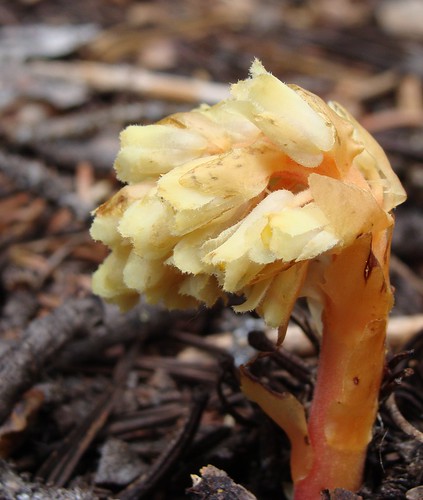Jesus apparently was teaching a lesson on trusting God for what we need. (See entire chapter.) So I am wresting scripture, or at least using it as it probably wasn't meant, but I have an excuse, namely that I'm not expounding on that Bible passage, but musing about a natural phenomenon. OK, sorry. Two more Bible references: Psalm 19 and Romans 1:20, where the Bible tells us that we can learn about God by observing nature.
First, what is a plant? Well, that's a good question. The Wikipedia says that, in the strict sense, plants are green organisms that carry out photosynthesis, and are multicellular. Unlike animal cells, which are generally flexible, plant cells have cell walls. As a result, the total plant is relatively inflexible, and cannot catch their food. They must make it, because they can't go after it. Plants have cellulose in their cell walls. There are some exceptions. A few plants can't carry on photosynthesis. This one can't:

(You can learn more about this plant by clicking on the photo as a link.) This plant is a close relative of plants that can carry out photosynthesis. It is multicellular. It even has flowers. But it has no chlorophyll, and doesn't carry on photosynthesis.
Fungi, and non-green algae, and bacteria, are not plants, to biologists of the 21st century. They used to be classified as such, but things have changed.
What is growth? Let's say that it means getting larger, and/or becoming more mature.
When animals grow, they basically add more cells. The cells do get larger, of course. If they didn't, every generation of cells would be half as large as the previous one, and soon the cells would be too small to function. But I grew by adding more cells, more or less all over my body, until I reached adult size. Plants do the same thing. They add more cells. But many plants do so in a somewhat different way. There are specialized tissues, called meristematic tissues, or meristem, where new plant cells are made, by cell division. For example, there is a cylinder of meristematic cells, between the bark and the wood of most trees, which is responsible for production of a new layer of wood each year. It is also responsible for production of a new layer of bark. That cylinder is called the vascular cambium. It divides, leaving new wood cells just inside the cylinder, and new bark cells just outside it. The vascular cambium makes its own new cells, too, and the cylinder expands, staying just outside the wood.
Buds have meristematic tissue in them. Some buds develop into flowers, some into leaves and twigs. Both types do so as their meristematic tissue produces more cells, which, after they have been split off, differentiate to take up their adult functions.
Animals have stem cells, of which plant meristematic cells are one type, but, generally, animals are more complex than plants, and animal cells, which lack a rigid cell wall, are more able to move and stretch out than plant cells, so it is more difficult to recognize animal stem cells.
We need to grow, too, as individuals and personalities. We don't do so in tiny compartments -- cells. We do so as a whole.
Oliver Wendell Holmes put it this way:
Build thee more stately mansions, O my soul,
As the swift seasons roll!
Leave thy low-vaulted past!
Let each new temple, nobler than the last,
Shut thee from heaven with a dome more vast,
Till thou at length art free,
Leaving thine outgrown shell by life’s unresting sea!
As the swift seasons roll!
Leave thy low-vaulted past!
Let each new temple, nobler than the last,
Shut thee from heaven with a dome more vast,
Till thou at length art free,
Leaving thine outgrown shell by life’s unresting sea!
- from "The Chambered Nautilus," Chapter four of The Autocrat of the Breakfast Table (public domain).
Thanks for reading!


No comments:
Post a Comment